The herbaceous annual, biennial or perennial plant Rudbeckia is a member of the Aster family. In this genus, there are approximately 40 species. In natural conditions, such flowers can mainly be found on the prairies of North America. In Africa and Europe, it is most cultivated. "Black-eyed Suzanne" - this is what the first settlers in North America called this plant, due to the fact that there is a middle of a dark color on the inflorescence. However, people living in Europe decided that the name "sun hat" suits the rudbeckia much better. This plant was named Rudbeckia by K. Linnaeus in honor of the Swedes father and son Rudbeks, who are botanists, while the younger of them was a teacher and friend of Linnaeus, and also great-great-grandfather of A. Nobel, and he is famous for having discovered the human lymphatic system in 1653.
Content
Features of rudbeckia
This flower has branched or simple shoots, which are rigidly pubescent, the height of which can vary from 0.5 to 2 meters. There are some wild species that can even reach a height of 3 meters. Cirro-divided or cirro-dissected whole leaf plates have an ovoid or oval shape. Their length varies from 5 to 20 centimeters, while in the upper part of the shoot they are sessile, and in the lower part they are long-petiolized. The diameter of the inflorescence baskets reaches 15 centimeters, they include sterile marginal ligulate flowers that can be painted in various shades of yellow, as well as bisexual median tubular flowers, painted in a variety of colors (from black-purple or brown to yellow). The fruit is an oblong achene, which sometimes has a small crown. Not very large glossy dark gray seeds remain viable for 2 or 3 years.
Growing rudbeckia from seeds
Sowing
All varieties and species, with the exception of terry varieties, can be propagated by seed. And perennials also reproduce by dividing the rhizome. Sowing seeds can be carried out directly into open soil. This is done in the second half of June on a pre-prepared bed.A distance of 15 centimeters is maintained between the seeds being laid out; they must be sprinkled on top with a thin layer of soil. Then the bed must be watered abundantly, while it must be carefully sprayed with water so as not to wash the seeds. In autumn, small leafy rosettes will appear on the garden bed, and next year they will become dense bushes, which will begin to bloom a little earlier than the rudbeky planted in spring. It should also be noted that this plant reproduces well by self-sowing. If you wish, you can do nothing with this, but simply thin out the emerging seedlings in the spring and not suffer with sowing.
Seedling
You can grow both annual and perennial rudbeckia through seedlings. Sowing is carried out in the last days of March or the first in April. Seeds are sown in seedling boxes, while they are sprinkled on top with a thin layer of substrate and only slightly sprayed with water, using a spray bottle. The container must be covered with a film and transferred to a place where the air temperature will be in the range of 20-22 degrees. The first seedlings can be seen in 7-14 days. Until the seedlings appear, the crops should be watered, if necessary, and the condensate that has appeared should be systematically ventilated and removed from the shelter. When the seedlings form 2 pairs of true leaves, they will need to be planted in such a way that they can grow normally without interfering with each other. When the plants take root, you should start hardening them. To do this, they must be transferred every day to the terrace or balcony for several hours.
Planting rudbeckia in open ground
What time to plant
Seedlings should be planted in open soil in the last days of May, but only after it is known for sure that night frosts will not return. For such a flower, you need to choose a well-lit place with a permeable, cultivated soil saturated with nutrients. If the soil is clayey, then sand is added to it for digging. It is also recommended to add compost to any soil before planting rudbeckia. When choosing a site, it should be remembered that this plant develops and grows normally even with not very strong shading.
Landing features
When planting between bushes, a distance of 0.3 to 0.4 meters must be observed. If the weather is warm, the planted flowers will take root very quickly. If it is rather cool outside (especially at night), then the seedlings transplanted into open ground will need to be covered with agrospan at night until they take root. Rudbeckia, which has taken root, can easily tolerate low temperatures even without shelter. When growing perennial species and varieties, it should be remembered that in the same place such a flower can grow for 3-5 years, in this regard, after planting, it is recommended to cover the soil surface on the site with a layer of mulch (compost), the thickness of which should be about 8 centimeters.
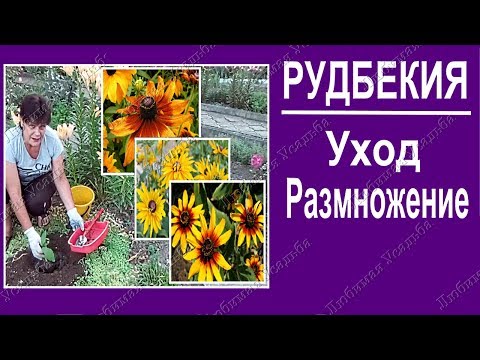

Watch this video on YouTube
Perennial rudbeckia care
It is necessary to care for rudbeckia, as well as for most garden flowers. It should be watered on time in the morning or in the evening, while if there is prolonged hot weather, then watering should be frequent. It should also be remembered that after each watering, the soil is loosened and, if necessary, weeding. If the variety or species is tall, then it must be tied to a support. At the very beginning of the growing season, it is necessary to feed such a plant; for this, a nutrient solution is used, consisting of 1 bucket of water, in which one large spoonful of potassium sulfate, nitrophoska and Agricola-7 should be dissolved. For 1 square meter of the site, 3 liters of such a solution are taken. After half a month, the rudbeckia is fed a second time using the same nutrient mixture. When the inflorescence begins to wither, it must be plucked with a part of the peduncle to the upper healthy leaf plate.
Transfer
In the event that such a flower is grown for more than 5 years without transplantation, then it has dense growth, which leads to clogging of the site. In order to avoid this, you should make a transplant on time. Dig up the plant and divide it into parts, which are then planted in a new bed, while remembering to keep the required distance between the copies. It should also be borne in mind that division or transplantation must be carried out until the moment when the intensive growth of the bush begins. Therefore, it is recommended to do this in early spring or when the rudbeckia has faded.
Reproduction
How to propagate such a plant by seeds, as well as dividing the bush, is described above. There are no other breeding methods.
Diseases and pests
Very rarely, rudbeckia gets sick with powdery mildew. At the same time, a loose bloom of white appears on the ground parts of the bush. To cure an infected specimen, it must be treated with a solution of colloidal sulfur (1%) or copper sulfate (80 grams of substance per bucket of water). If brown spots appeared on the leaf plates, they began to thin out and fade, then this means that the bush is infected with a leaf nematode. In this case, the affected and injured rudbeckia should be removed from the site, and the remaining bushes are treated with Nemagon, Basamid or Nemaphos for preventive purposes, while adhering to the instructions attached to the drug. In the event that annual plants have been damaged, then with the onset of autumn it will be necessary to destroy all their remnants, while the site is thoroughly dug up and spilled with a solution of potassium manganese, which must be very strong.
Of the pests for such a flower, caterpillars and larvae are dangerous. But it should be remembered that if you properly care for rudbeckia, then you will not have any problems with its cultivation, since the plant has a sufficiently high resistance to diseases and pests.
After flowering
Seed collection
The end of flowering and seed ripening occurs in the autumn. Collecting seeds should only be done after they have dried well on the plant itself. Then you need to put on garden gloves and carefully collect them exclusively from the central part of the flower. The seeds are then scattered onto a piece of newspaper and placed in a well-ventilated room for ventilation.
Perennial wintering
In the autumn, it will be necessary to cut off the aerial part of the perennial rudbeckia to the surface of the site. Such a plant must be covered for the winter. To do this, the site is covered with a thick layer (from 5 to 7 centimeters) of humus, or the plants are covered with dried grass, or spruce branches can be used.
Types and varieties of rudbeckia with photos and names
Those species and varieties of rudbeckia that are grown by gardeners are divided into perennials and annuals (they are also called biennials).
Annual rudbeckia
Hairy rudbeckia (Rudbeckia hirta)
Her homeland is North America. This type is cultivated as an annual or biennial plant. Stiff-pubescent shoots can be branched or simple, and they reach a height of about 100 centimeters. The basal leaf plates are ovoid, whole have petioles, and the stem plates are alternately located, hairy, broadly lanceolate, sessile, with large teeth. Baskets-inflorescences are located on long peduncles, and in diameter they can reach 10 centimeters. The tubular flowers are purple-gray, and the ligulate ones are yellow, with a convex receptacle. Such undersized varieties are often cultivated as: Goldflamme and Toto Rustic, reaching a height of 0.35 m; Indian Summer and Marmalade, having a height of about 0.45 m; Goldstrum, which has a height of about 0.6 m, and the diameter of its simple inflorescences is 10 centimeters.
Rudbeckia bicolor (Rudbeckia bicolor)
The height of such a bushy upright rudbeckia can vary from 0.25 to 0.7 meters.On the surface of the shoots there is pubescence, the shape of the leaf plates is lanceolate. The diameter of the inflorescences with a rich color can reach from 6 to 8 centimeters, they have 2 rows of reeds of flowers, colored orange or yellow, sometimes with a black-purple base. On a cylindrical receptacle about 20 mm high, tubular flowers are almost black in color. Rudbeckia begins to bloom in the second half of June, and ends after the onset of frost. The most popular variety is Herbstwald: the bush reaches a height of 50 centimeters, and the diameter of the inflorescence baskets is about 7 centimeters, with tubular black flowers and reed flowers - brown-red.
Rudbeckia grasping (Rudbeckia amplexicaulis)
The bush reaches a height of 0.8 m. Sitting oppositely positioned bare leaf plates can have an elongated or oval shape with a pointed apex and a finely toothed edge. The color of the reed flowers is deep yellow, tubular dark brown are placed on a receptacle that rises up to 30 mm.
Rudbeckia triloba (Rudbeckia triloba)
The bush reaches a height of 1–1.4 m, its flowering is short, but very abundant. The lower leaf plates are three-lobed, and the stem plates are oval and dark green in color. Small inflorescences consist of dark brown tubular and yellow reed flowers.
Perennial rudbeckia
Rudbeckia brilliant, or radiant rudbeckia (Rudbeckia fulgida)
The bush reaches a height of about 0.6 m. The narrow lanceolate leaf plates are solid. The diameter of the inflorescences is about 9 centimeters, they include tubular dark red and ligulate orange flowers. There is a variety of "variabis", its median flowers are dark purple, and the marginal flowers are yellowish-orange. Also quite popular with gardeners are the Goldstar and Goldsturm varieties, which have a convex middle of a brown color and reed flowers of a golden color.
Rudbeckia dissected (Rudbeckia laciniata)
The bush can reach a height of 200 centimeters. The highly branched rhizome is horizontal. Stem leaf plates are tripartite, and the lower ones are pinnately separate. In diameter, the inflorescence baskets reach 10 centimeters, they include from 1 to 3 rows of marginal flowers of a deep yellow color and pale yellow tubular. There are a large number of varieties, but the most popular of them is the "Golden Ball": this semi-double or double plant has inflorescences, reaching a diameter of 10 centimeters, which consist of tubular light green flowers and marginal - a rich yellow color.
Western rudbeckia (Rudbeckia occidentalis)
This species is extremely interesting in that its inflorescences are outwardly similar to tongueless chamomile. The plant can reach a height of 1.2–1.5 meters. For example, the Black Beauty variety is very unusual: it completely lacks reed flowers, therefore, its inflorescences look like a black cone, which is surrounded by green bracts.
Giant rudbeckia (Rudbeckia maxima)
The bush of this species is relatively large. On the surface of the green leaf plates, there is a layer of waxy bloom of a bluish color. Deep yellow ligulate flowers are located on a very prominent cone-shaped receptacle, while tubular ones are painted in dark colors. This species is highly resistant to frost and drought. Inflorescences located on long peduncles can be used for cutting.
Rudbeckia lustrous (Rudbeckia nitida)
The height of the bush is about 200 centimeters. Glossy sheet plates have an oblong-lanceolate shape. The diameter of the inflorescences is about 12 centimeters. They consist of green tubular flowers and yellow reed flowers. There are such very beautiful varieties as: Goldshrim and Herbston.
Beautiful rudbeckia or beautiful (Rudbeckia speciosa)
The height of the bush can vary from 0.5 to 0.6 meters. Rounded or oblong sheet plates have an uneven edge.The inflorescences-baskets, the diameter of which can reach 10 centimeters, include tubular flowers of a brownish-black color and yellowish-orange reed flowers, having 3 cloves at the end of the limb.
Rudbeckia hybrid (Rudbeckia hybrida)
This species unites varieties of rudbeckia hairy, glossy and dissected, which have rather large inflorescences-baskets (diameter about 19 centimeters), consisting of tubular flowers of brown color with a purple tint, and brownish-yellow reed, having a length of about 14 centimeters. As an example, the following varieties can be considered:
- Gloriosa Daisy - grown as an annual or perennial, the height of the bush is about 1.2 m, the diameter of the inflorescences is about 16 centimeters, they include 1-3 rows of monochromatic or variegated flowers of brownish-yellow or yellow flowers, and the middle of the tubular shape is painted in dark brown ;
- Double Daisy - strongly branching rough shoots in height can reach 1.2 m, ovoid whole leaf plates are heavily pubescent, the diameter of double inflorescences is about 17 centimeters, they include tubular brown flowers and ligulate, which can be variegated or monochromatic.
Echinacea or rudbeckia
The medicinal properties of echinacea have been known for a long time. Interestingly, in 1753, echinacea purpurea by Karl Linnaeus was ranked among the genus rudbeckia. Both plants are native to the North American prairies of the southeastern United States, and they prefer to grow in nutritious, moist soil outdoors. But Mönch, who is a German botanist, in 1794 brought Echinacea purpurea, which until that time was called rudbeckia purpurea, into a separate genus.
What are the differences between these colors? For example, they have different color of inflorescences, for example, in rudbeckia, reed flowers can be of different shades of yellow, brown and orange, and in echinacea - crimson or purple. Echinacea has tough, very prickly, subulate-pointed bracts and a receptacle, while in rudbeckia they are soft. This feature can be traced in the name of echinocea - "echitnos", which is translated from Greek as "prickly". Echinacea also stands out for its medicinal properties, which, despite the assurances of some people, are completely absent from rudbeckia.
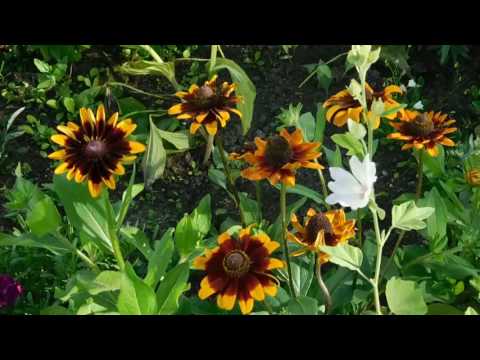

Watch this video on YouTube

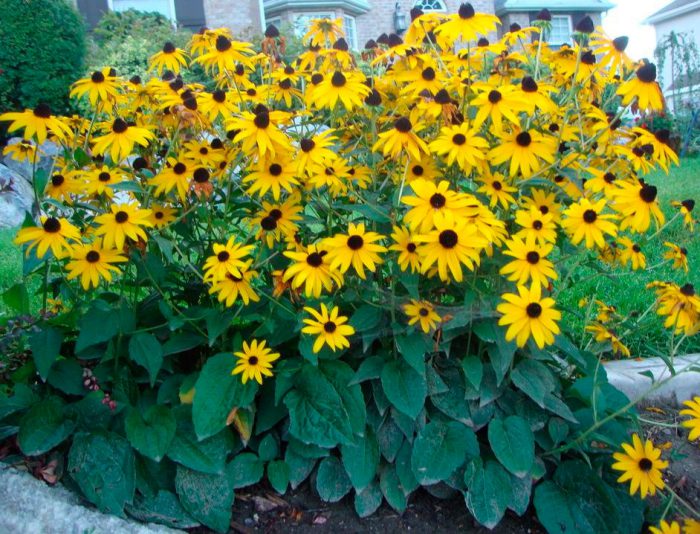

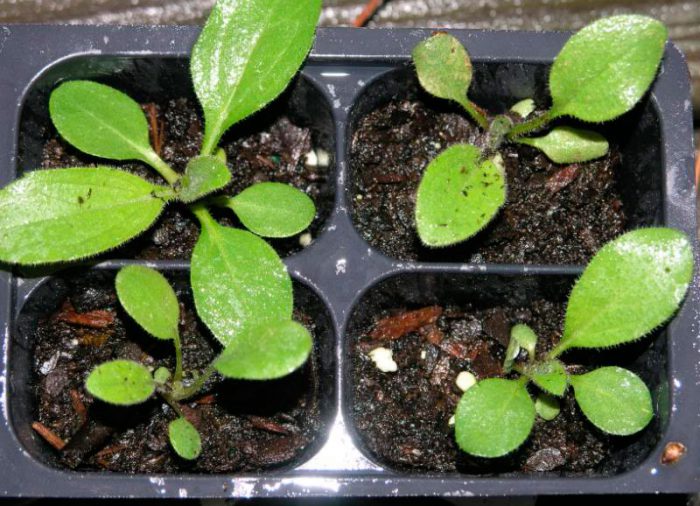


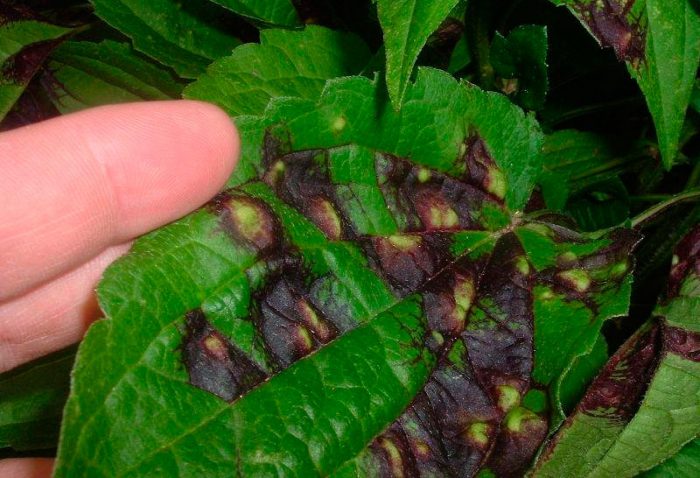
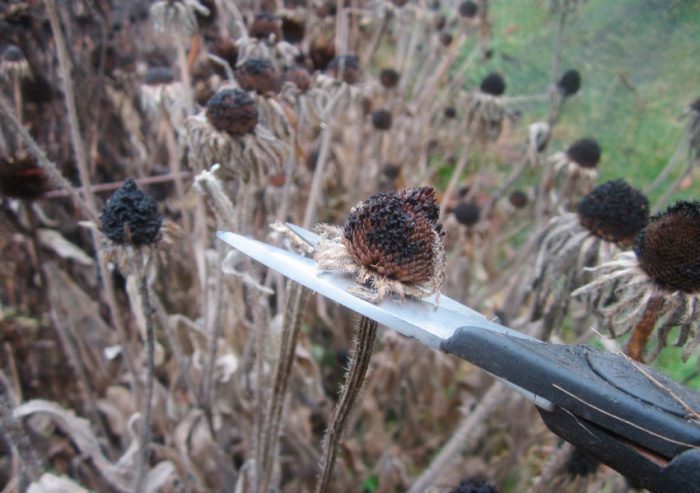
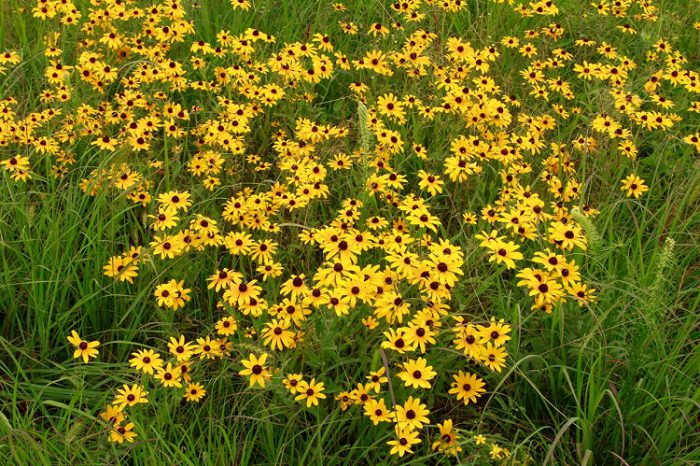
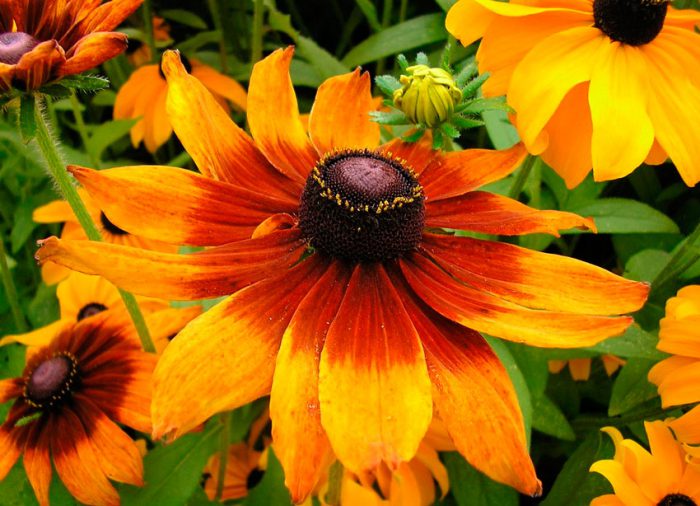
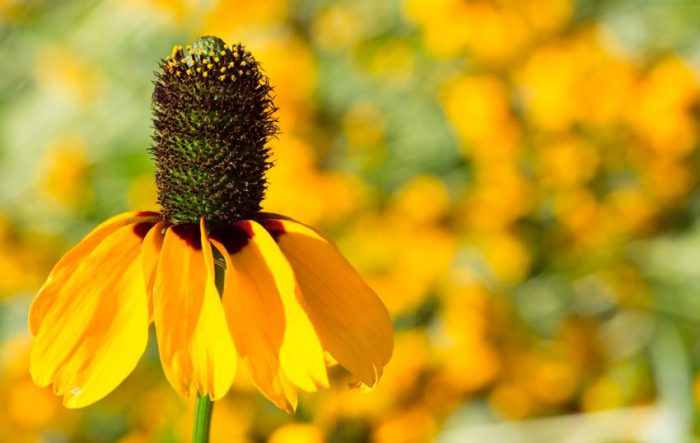

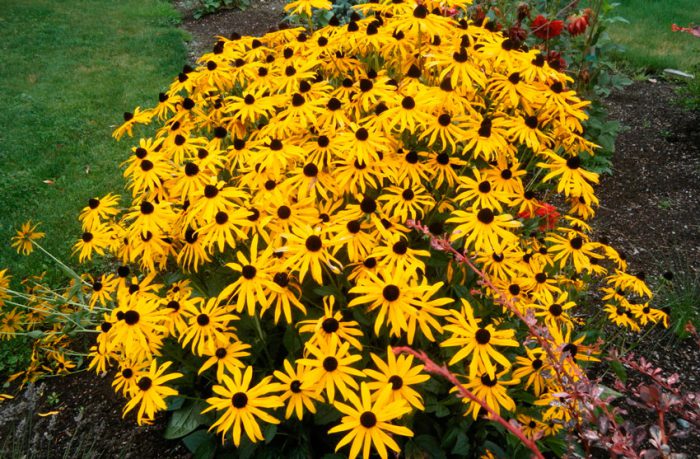

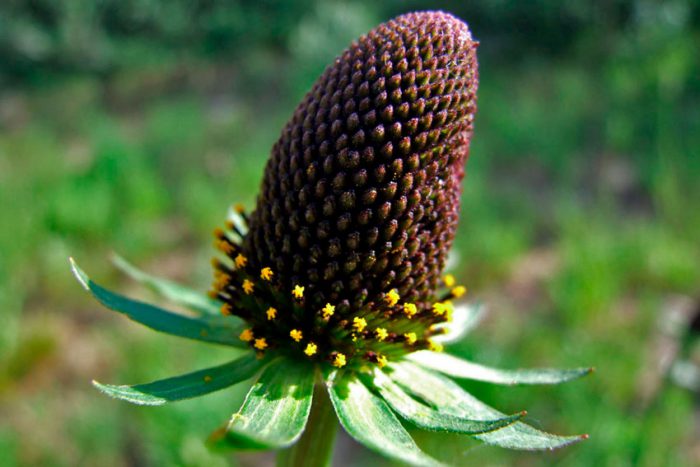
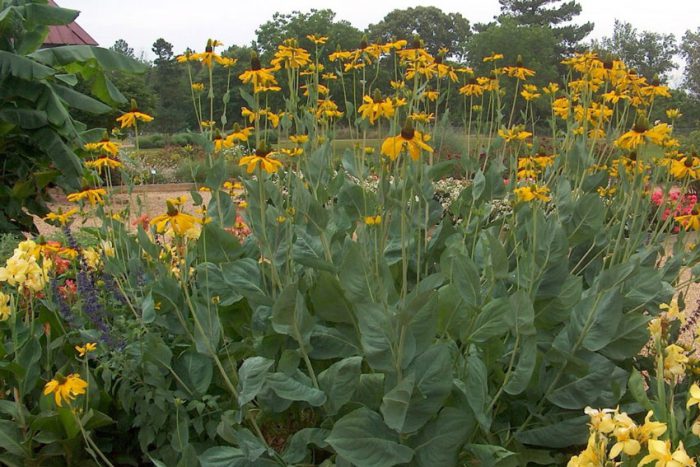

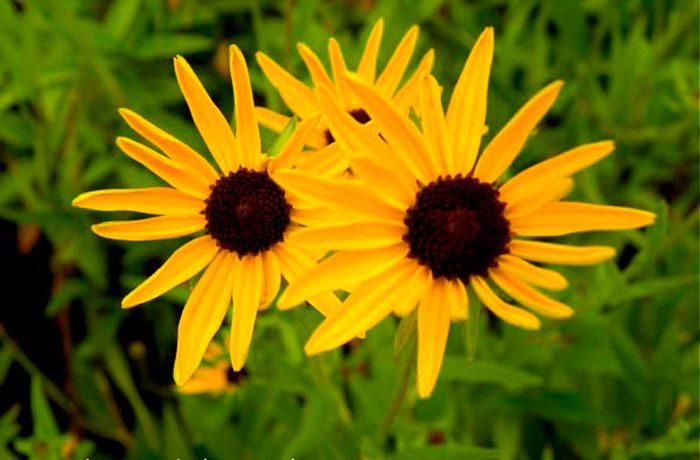
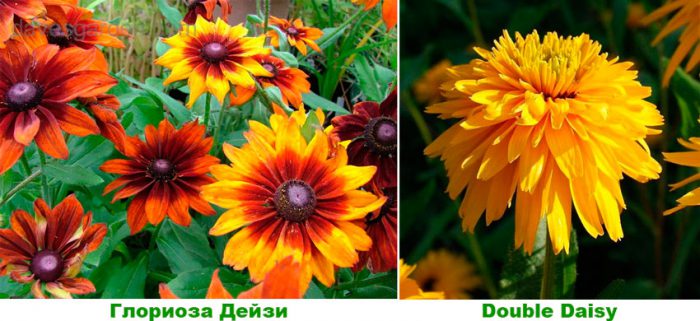


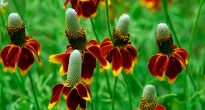
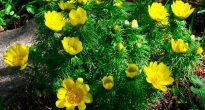







Where is the Golden Ball? Like rudbeckia too? or I'm wrong?